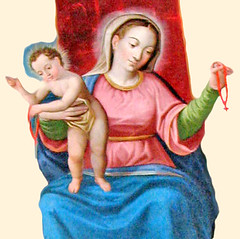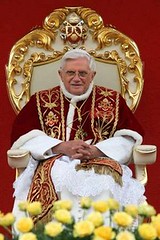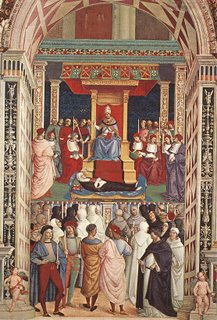The Life of St Catherine of Siena

Today Holy Mother Church rejoices in the Feast of St Catherine of Siena, she who has been called a Second Founder of the Order of Preachers. Together with St Teresa of Avila, she was one of the first women to be declared a Doctor of the Church by Pope Paul VI in 1970 and she was subsequently proclaimed a Patroness of Europe. Both these marks of recognition from the Church are signs of the Church's high regard for his spiritual doctrine and mystical revelations; noteworthy too is St Catherine's love for the Church and her zeal for the unity and renewal of the Spouse of Jesus Christ, who Himself was her Mystical Bridegroom. Hence she proclaimed: "We should pass through the door of Jesus Christ, the Crucified, a door which can only be found in holy Church." Her deep love for Christ and His Body, the Church is just one of many precious examples we can learn from this great saint.
Following is a Biographical Sketch which I prepared for our Novitiate classes:
"Catherine was born around 1347 in Siena, the twenty-third of twenty-five children. Her father Jacopo Benincasa was a fairly prosperous dyer and her mother was called Lapa. Their house was on a steep hill below the Dominican church of San Domenico in Siena. At this time, Siena was a self-governing republic, in the shadow of the great republic of Florence. At this time, between 1305 and 1378 all the popes were Frenchmen, governing the Church from Avignon in Provence. Because of the papal absence from Rome the Papal States were in chaos and Rome itself was in the grip of a power struggle between the aristocratic families of the City.
Catherine herself must have grown up in the chaos of her huge family. Kenelm Foster, OP says that “in the swarming hurly-burly of her home Catherine grew up in full contact with human realities.” She grew up quickly too in Christian piety and when she was six she saw her first vision of Christ over the Dominican priory. A year later, she vowed her virginity to Jesus. At the age of fifteen, at the advice of her cousin, a Dominican friar and her first spiritual director, she renewed her vow of virginity by cutting off her hair, a step that brought her into sharp conflict with her family until Jacopo, convinced at last that this daughter of his was no ordinary girl, ordered Lapa and the rest to let her be. Indeed, it has been said that these were the first signs of a stubborn independence that was to be a hallmark of most of her life. Yet, she is described as “a strikingly pleasant and outgoing youngster, imaginative and idealistic in her devotion.”
Unusually, she was allowed the rare privilege of a room of her own in the attic and she remained there, praying day and night, only leaving it to go to church or help with the housework. At the age of eighteen, she got herself admitted, against stiff opposition, because of her youth, into a Dominican lay sisterhood called the Mantellate. This did not make her a nun but it gave her the black and white Dominican habit and incorporated her into the wider family of the Order. The Mantellate were actually widows who served the needs of the poor and the sick under the direction of a prioress and ultimately the friars. She continued to live at home but in even stricter seclusion, leaving her room only to go to Mass at San Domenico, until about three years later, around 1368, she received an order from Christ to come out of her solitude and to love her neighbour as herself. She was twenty-one years old.She immediately rejoined her family and gave herself to the service of the poor and the sick with the Mantellate. She served as nurse in homes and hospitals, looked out for the destitute and buried her father. This period of activity seems to have come after her ‘mystical espousal’ to Christ, which had climaxed her period of solitude. Her ministry quickly took her beyond the lepers, plague victims, poor, sick and homeless victims of Siena, and she began to address her considerable energies to peace-brokering between the warring Italian city-states, correcting abuses of power and privilege, reforming the Dominican order and even restoring the papacy to Rome.
Yet she still continued to have daily times of silence and contemplation after which she would have conversations with those who gathered around her room. In these conversations she learned the subtleties of theological argument and biblical interpretation and she taught what she knew from experience of the way of God. These people – lay men and women, Dominicans, secular clergy and even members of the aristocracy – who gathered around her saw themselves as a spiritual family and called her ‘Mother’.
Mystical experiences continued to increase and intensify and in 1370 she experienced her ‘mystical death’ – four hours during which she experienced ecstatic union with God while her body seemed lifeless to all observers. Although only twenty-three then, she experienced an exchange of hearts with Jesus who said to her: “See, dearest daughter, a few days ago I took your heart from you; now, in the same way, I give you my own heart. For the future, it is by [this heart] that you must live.” And this seemed to be the case! Her austerities increased and she abstained from food and sleep almost entirely!
In 1374, she travelled to Florence, summoned some say, for the General Chapter of the Order. Here she formed a life-long friendship with St Raymond of Capua, who became her spiritual director and confessor. It seems that she was also investigated by the Chapter and duly exonerated, returning to Siena with a friar who would become not only a spiritual director but a disciple and friend.
In 1375 she travelled to Pisa to convince Pisa against joining an anti-papal league and she even preached a crusade to deliver the Holy Land, believing that Christian armies ought to direct their energies to this effort rather than warring against one another. It was in Pisa in St Christina’s church that she received the stigmata which she was to bear invisibly – at her request – until her death. In 1376, she travelled to Avignon to plead for Florence which was interdict for taking up arms against the papal armies. Although she was unsuccessful in this regard, due to Florentine treachery, she turned her energies instead to telling the pope Gregory XI about her ideas for a crusade, the reform of the clergy and most importantly, the return of the papacy to Rome. Catherine’s insistence on this matter strongly influenced the pope in his actual move and return to Rome.
Gregory XI entered Rome in January 1377 but died within a year. The Roman mob demanded an Italian pope and the cardinals elected Urban VI, the first non-French pope in sixty years. But this pope was “impulsive, violent and mentally unstable” and so after four months of aggravation, the French cardinals fled to Avignon, nullified Urban’s election on grounds of duress and elected Robert of Geneva as Clement VI. This anti-pope established his papacy at Avignon and thus the Great Western Schism had begun – a tragic consequence of Catherine’s good intentions.
During these turbulent times, Catherine wrote many letters to any and all who were involved pleading for loyalty and unity. Despite Urban VI’s shortcomings, Catherine defended his papacy as she believed in the office of Pope and its significance for the unity of the Church. Indeed, we can identify renewal and reform in the Church as one of her great themes.
In 1378 she was summoned to Rome. She left Siena with her disciples and set up a household in Rome where lived on alms. She laboured for eighteen months, preaching, writing, praying for unity. She pushed herself to the limits of her energies and still she failed. At last in 1380, she fell seriously ill and was unable (or unwilling) to eat or even swallow water. For two months she lay paralyzed and diabolic visions tormented her as much as mystical ecstasy ravished her. She died on 29 April 1780, aged just thirty-three.
She was canonized in 1461."
On this day, let us sing God's praises and thank Him for the gift of St Catherine of Siena, whose example and witness to Truth still inspires so many. I pray especially for all the apostolic sisters of the Order of Preachers who follow in her footsteps and who have St Catherine as their patroness. May she make the work of our Order fruitful in praising, blessing and preaching the love and truth of Jesus Christ.
The statue (above centre) of St Catherine is from the facade of San Esteban church in Salamanca.








0 Comments:
Post a Comment
<< Home